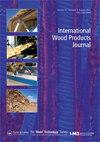马来西亚婆罗洲7-23岁人工林生长的糙皮桉的贴面和锯切性能
IF 0.9
Q2 MATERIALS SCIENCE, PAPER & WOOD
引用次数: 8
摘要
在马来西亚婆罗洲的沙巴州和沙捞越州,人工林种植的高价值木材品种生产高价值的最终产品是优化土地利用的关键,同时满足下游加工的需求。贝利塔桉是一种适合热带气候条件的树种,在实木和单板生产方面具有相当大的潜力。沙巴州生长的佩利塔的特点表明,需要适当的造林管理和下游加工战略,以优化贴面和锯板的质量和数量。从糙皮草资源中回收表明,干燥分级单板的平均体积回收率为38.1% ~ 49.5%,而干燥板的平均体积回收率为48.5% ~ 57.9%。如果要在短时间内作为一种剥皮资源种植,则需要适当的修剪制度以最大限度地增加明木的体积。造成体积损失的最大原因是单板和实木回收过程中的端裂。本文章由计算机程序翻译,如有差异,请以英文原文为准。
Veneering and sawing performance of plantation-grown Eucalyptus pellita, aged 7–23 years, in Borneo Malaysia
ABSTRAC Plantation-grown, high-value timber species producing high-value end products are key to optimising land utilisation in Sabah and Sarawak states in Borneo, Malaysia, while meeting the demand for downstream processing. Eucalyptus pellita is one such species suitable for the tropical climatic conditions and exhibits considerable potential for solid wood and veneer production. The characteristics of E. pellita grown in Sabah, demonstrate the need for an appropriate silviculture management and downstream processing strategy to optimise the quality and quantity of veneer and sawn board. Recovery from E. pellita resources has demonstrated the average volume recovery of dry-graded veneer ranged from 38.1 to 49.5%, whereas the average dried board volume ranged from 48.5 to 57.9%. If E. pellita is to be grown on short rotations as a peeler resource, an appropriate pruning regime is needed to maximise the volume of clearwood. The greatest cause of volume loss was end-splitting in the recovery of veneer and solid timber.
求助全文
通过发布文献求助,成功后即可免费获取论文全文。
去求助
来源期刊

International Wood Products Journal
MATERIALS SCIENCE, PAPER & WOOD-
CiteScore
2.40
自引率
0.00%
发文量
27
 求助内容:
求助内容: 应助结果提醒方式:
应助结果提醒方式:


